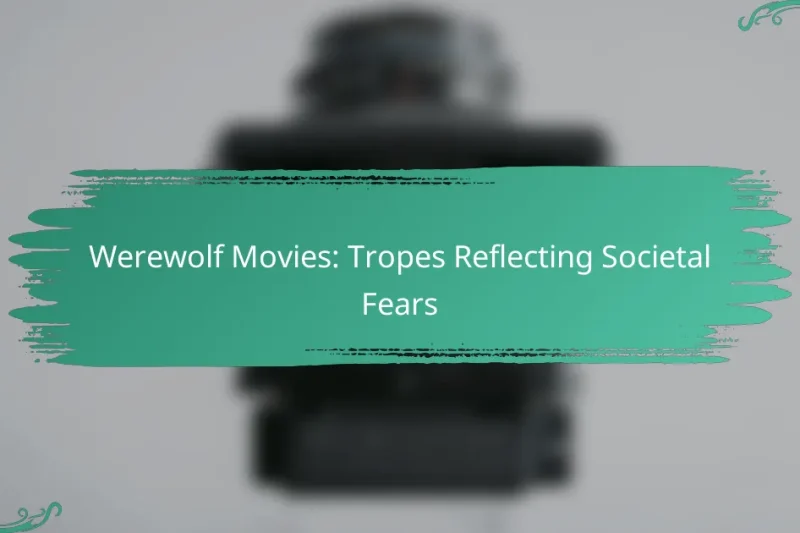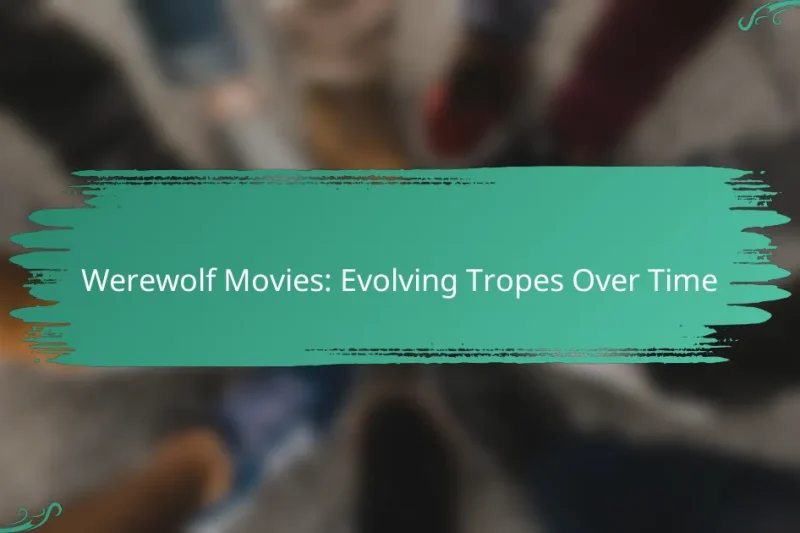Werewolf movies serve as a compelling lens through which to examine societal fears, particularly those related … Werewolf Movies: Tropes Reflecting Societal FearsRead more
Werewolf Movie Tropes
Werewolf movies are rich with familiar tropes that captivate audiences, such as transformations during the full moon and the internal conflict between human and beast. These films often explore the painful and violent nature of transformation, delving into the complexities of human nature and primal instincts. By blending horror, suspense, and dark humor, notable titles like “American Werewolf in London” and “Ginger Snaps” offer unique interpretations of the werewolf mythos.
Werewolf Movies: Tropes Challenging Gender Roles
Werewolf movies serve as a compelling lens through which to examine and challenge traditional gender roles, … Werewolf Movies: Tropes Challenging Gender RolesRead more
Werewolf Movies: Evolving Tropes Over Time
Werewolf movies have evolved significantly over the years, transitioning from traditional horror to incorporate diverse storytelling … Werewolf Movies: Evolving Tropes Over TimeRead more
Werewolf Movies: Tropes in Popular Culture
Werewolf movies are characterized by a set of defining tropes, including transformation, lunar influences, and the … Werewolf Movies: Tropes in Popular CultureRead more
What are common werewolf movie tropes?
Common werewolf movie tropes include transformation during the full moon, the struggle between human and beast, romantic entanglements with humans, intense hunting scenes, and pack dynamics. These elements create a familiar framework that audiences recognize and engage with in werewolf narratives.
Transformation under the full moon
A hallmark of werewolf films is the transformation that occurs during the full moon. This trope often depicts a painful and dramatic change from human to wolf, emphasizing the loss of control and the primal instincts that emerge. The full moon serves as a powerful symbol, marking the time when the beast is unleashed.
Filmmakers frequently use special effects to illustrate this transformation, showcasing the physical and emotional turmoil experienced by the character. This visual spectacle heightens the tension and draws viewers into the horror of the metamorphosis.
Conflict between human and beast
The internal struggle between the human side and the beastly instincts is a central theme in werewolf movies. Characters often grapple with their dual nature, leading to moments of self-doubt and fear of harming loved ones. This conflict adds depth to the narrative, making the characters relatable and their plight more tragic.
Writers often explore themes of identity and morality through this conflict, questioning what it means to be human when primal urges take over. This duality can lead to dramatic confrontations, both internal and external, as characters seek to reconcile their two halves.
Romantic subplot with a human
Many werewolf films feature a romantic subplot involving a human character, which adds an emotional layer to the story. This relationship often serves as a catalyst for the werewolf’s struggle, highlighting the desire for connection amidst the chaos of their transformation. The human partner may represent hope or a sense of normalcy.
These romantic entanglements can create tension, especially if the werewolf fears harming their partner. This dynamic not only enhances the drama but also allows for poignant moments of vulnerability and connection between the characters.
Hunting scenes
Hunting scenes are a staple in werewolf movies, showcasing the creature’s predatory nature. These sequences often involve intense chases, highlighting the thrill and danger of being hunted or being the hunter. They serve to amplify the horror elements and showcase the werewolf’s physical prowess.
Filmmakers utilize suspenseful cinematography and sound design to create a gripping atmosphere during these scenes. The stakes are raised as characters face the terrifying reality of the werewolf’s capabilities, making for memorable and heart-pounding moments.
Pack dynamics
Pack dynamics play a crucial role in many werewolf narratives, emphasizing the social structure and hierarchy among werewolves. These dynamics can influence character behavior, loyalty, and conflict, often mirroring real-world social interactions. The pack may operate under a leader, with various roles assigned to its members.
Exploring pack relationships can add complexity to the story, as characters navigate loyalty to their pack versus their human side. This tension can lead to conflicts that drive the plot forward, creating opportunities for betrayal, alliances, and deeper character development.
How do werewolf movies portray transformation?
Werewolf movies typically depict transformation as a painful and often violent process, highlighting both physical and psychological changes. This transformation serves as a central theme, exploring the duality of human nature and the struggle between civilization and primal instincts.
Physical changes
The physical transformation in werewolf films is often characterized by dramatic alterations to the body, including increased muscle mass, hair growth, and changes in facial structure. These transformations are usually depicted with intense special effects, emphasizing the agony and horror of becoming a werewolf.
Common visual elements include elongated limbs, sharp claws, and fangs, which symbolize the shift from human to beast. The transformation is often triggered by the full moon, reinforcing the connection between lunar cycles and the werewolf mythos.
Mental struggle
The mental struggle during transformation is a key aspect of werewolf narratives, showcasing the internal conflict between the human self and the beastly instincts. Characters often experience a loss of control, grappling with violent urges and the fear of harming loved ones.
This struggle can lead to themes of guilt and identity crisis, as the transformed individual battles the consequences of their actions. The psychological turmoil adds depth to the story, making the transformation not just a physical change but a profound personal crisis.
Symbolism of loss
The transformation into a werewolf symbolizes a loss of humanity and the surrender to primal instincts. This loss is often portrayed as a metaphor for the darker aspects of human nature, such as aggression and savagery.
Additionally, the transformation can represent the fear of losing control over one’s life or the consequences of unchecked desires. In many films, the werewolf becomes a tragic figure, embodying the struggle to reconcile one’s human side with the beast within.
What are the best werewolf movies to watch?
The best werewolf movies blend horror, suspense, and often dark humor, showcasing the transformation and struggles of their characters. Notable films in this genre include “American Werewolf in London,” “Dog Soldiers,” “Ginger Snaps,” and “Wolfman,” each offering unique takes on the werewolf mythos.
American Werewolf in London
<p"American Werewolf in London" is a classic that combines horror and comedy, telling the story of two American backpackers who encounter a werewolf in the English countryside. The film is renowned for its groundbreaking special effects, particularly the transformation scene, which remains iconic in horror cinema.
The movie explores themes of guilt and the loss of humanity, making it not just a horror film but a deeper commentary on the human condition. Its blend of humor and horror has influenced many films that followed.
Dog Soldiers
“Dog Soldiers” is a British horror film that pits a group of soldiers against a pack of werewolves during a training exercise in the Scottish Highlands. This film stands out for its intense action sequences and strong character development, showcasing the soldiers’ camaraderie as they fight for survival.
The film effectively uses practical effects to create tension and fear, making the werewolves both terrifying and believable. Its mix of military action and horror elements has garnered a cult following among genre fans.
Ginger Snaps
“Ginger Snaps” offers a unique perspective on the werewolf myth by intertwining it with themes of adolescence and female empowerment. The story follows two sisters, one of whom transforms into a werewolf after being bitten, symbolizing the struggles of growing up and the changes that come with puberty.
This film is notable for its strong female characters and social commentary, making it more than just a horror movie. It addresses issues like body image and the transition from girlhood to womanhood, resonating with many viewers.
Wolfman
“Wolfman,” a remake of the 1941 classic, stars Benicio del Toro as a man who returns to his ancestral home and becomes cursed with lycanthropy. The film features a darker, more gothic atmosphere, emphasizing the tragic elements of the werewolf legend.
With impressive visual effects and a strong supporting cast, including Anthony Hopkins, “Wolfman” explores themes of family, legacy, and the struggle between man and beast. Its production values and storytelling make it a notable entry in the werewolf genre.
How do werewolf movies compare to vampire films?
Werewolf movies often emphasize transformation and primal instincts, while vampire films focus on seduction and immortality. Both genres explore themes of humanity versus monstrosity, but their approaches and character arcs differ significantly.
Different mythologies
Werewolf mythology typically centers around the idea of a human transforming into a wolf during a full moon, influenced by folklore from various cultures. In contrast, vampire legends often involve bloodsucking creatures who can be immortal, with roots in Eastern European tales. Each mythology brings unique rules, such as the need for silver to kill a werewolf or the vulnerability of vampires to sunlight and garlic.
These mythologies shape the narratives, with werewolves often portrayed as tragic figures battling their animalistic urges, while vampires are frequently depicted as charismatic yet predatory beings. The cultural background of each creature influences the storytelling style and character development in films.
Character motivations
In werewolf films, characters often grapple with their dual nature, torn between human morality and animalistic instincts. This internal conflict drives the plot, leading to themes of loss of control and the struggle for redemption. Characters may seek to understand or cure their condition, reflecting a desire for acceptance and normalcy.
Conversely, vampire characters are usually motivated by power, immortality, and the pursuit of pleasure. Their narratives often explore themes of loneliness and existential dread, as they navigate relationships with humans while facing their own cursed existence. This difference in motivations creates distinct emotional arcs and conflicts within each genre.
Visual aesthetics
Werewolf movies often employ dark, gritty visuals to convey the rawness of transformation and the primal nature of the beast. The use of practical effects, such as makeup and animatronics, enhances the visceral experience of the transformation scenes. Settings are typically rural or forested, emphasizing isolation and the wildness of the werewolf’s nature.
In contrast, vampire films often feature a more glamorous aesthetic, with elegant costumes and moody lighting that highlight the seductive qualities of the characters. Gothic architecture and urban settings are common, creating a sense of allure and danger. This visual distinction reinforces the thematic differences between the two genres, appealing to different audience sensibilities.
What are the psychological themes in werewolf films?
Werewolf films often explore themes of duality, transformation, and the struggle between human nature and primal instincts. These psychological elements reflect deeper fears and desires, showcasing the conflict between civilization and savagery.
Duality of Human Nature
The concept of duality is central in werewolf films, illustrating the coexistence of civilized behavior and primal instincts within individuals. Characters often grapple with their inner beast, representing the darker aspects of humanity that emerge under stress or transformation.
This theme resonates with viewers, as it reflects the universal struggle to balance societal expectations with innate desires. Films like “An American Werewolf in London” highlight this conflict through character development and visual storytelling.
Transformation and Identity
Transformation is a key psychological theme, symbolizing the fear of losing control over one’s identity. The metamorphosis into a werewolf often serves as a metaphor for adolescence, sexuality, or mental illness, portraying the anxiety surrounding these changes.
For instance, in “The Howling,” the transformation process emphasizes the loss of self and the chaotic nature of change. This theme encourages audiences to confront their own fears regarding identity and the unknown.
Primal Instincts vs. Civilization
The tension between primal instincts and civilized behavior is a recurring theme in werewolf narratives. These films often depict characters torn between their animalistic urges and the constraints of societal norms, leading to dramatic conflicts.
In “Ginger Snaps,” the protagonist’s transformation into a werewolf parallels her journey into womanhood, illustrating the struggle against societal expectations. This theme invites viewers to reflect on their own instincts and the societal pressures that shape their behavior.



